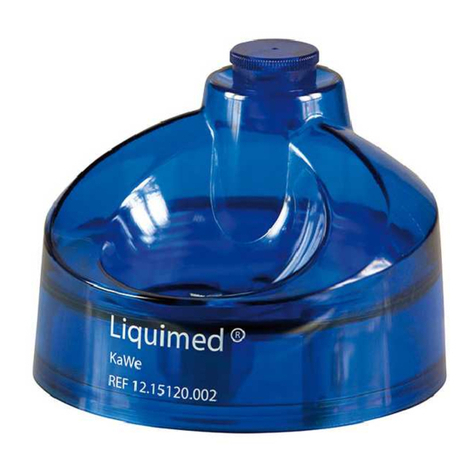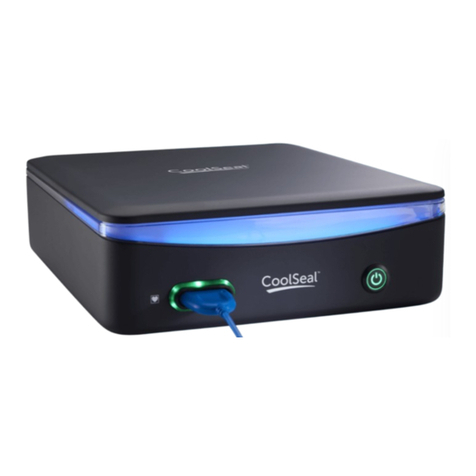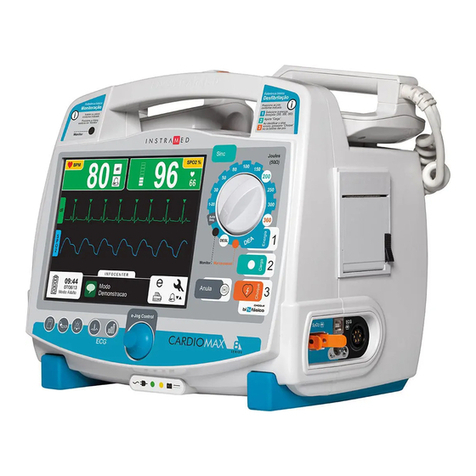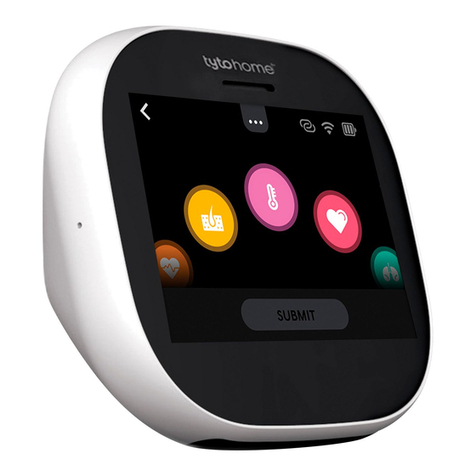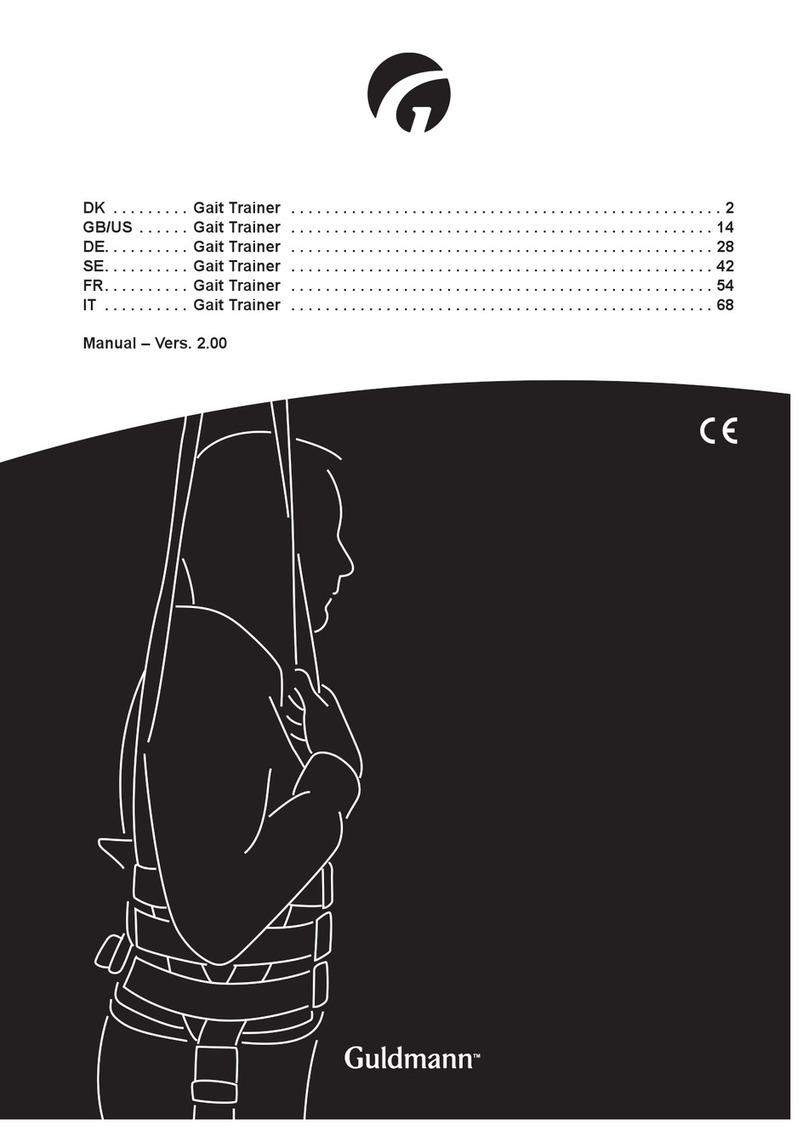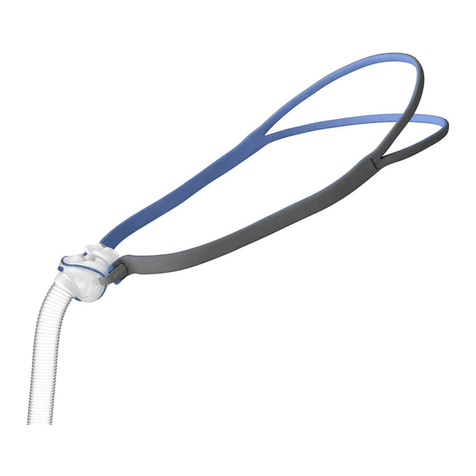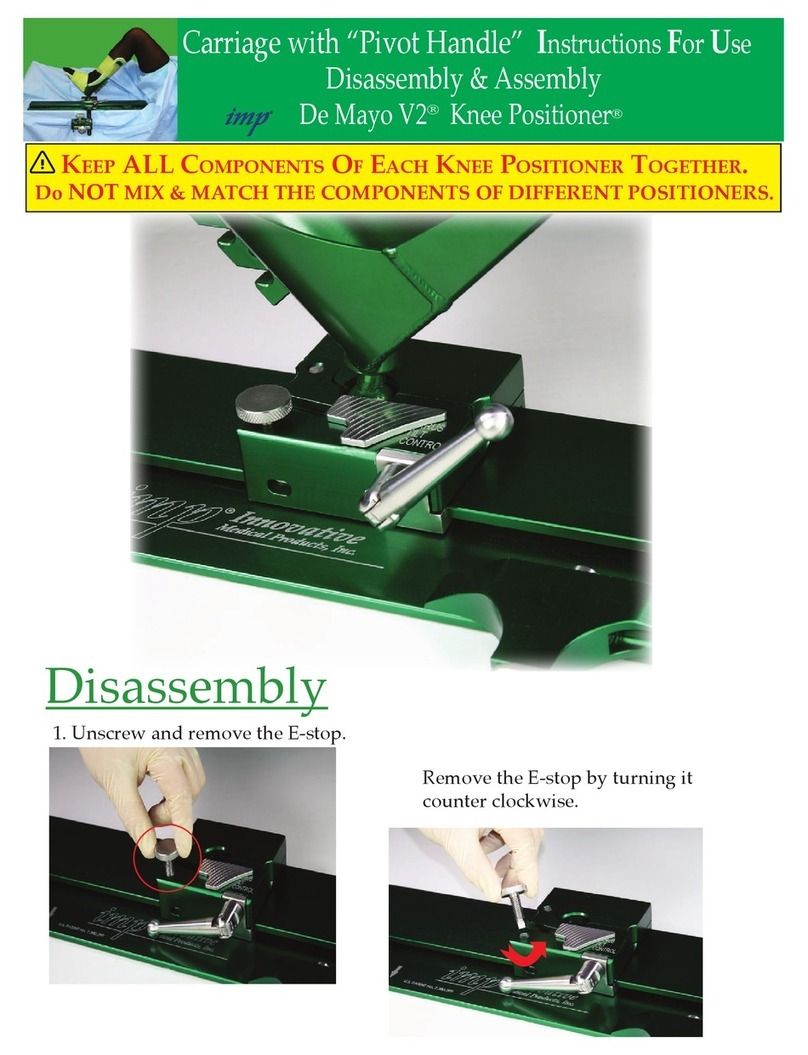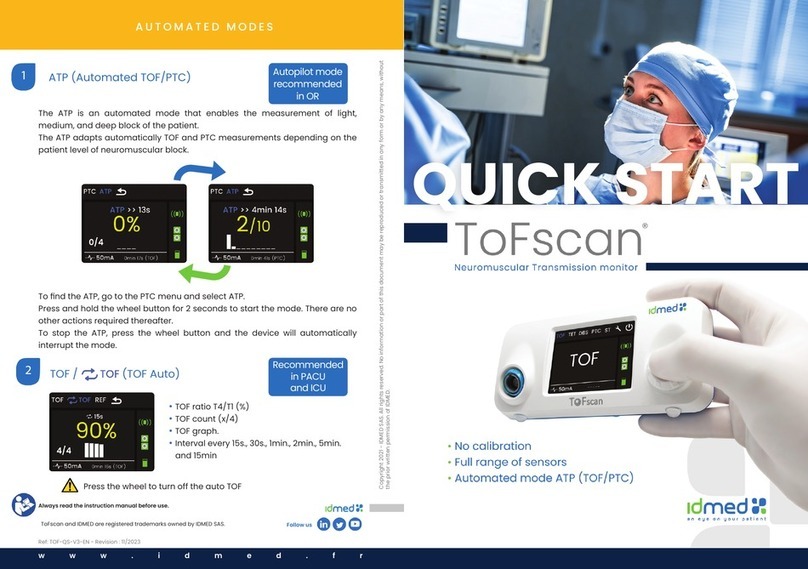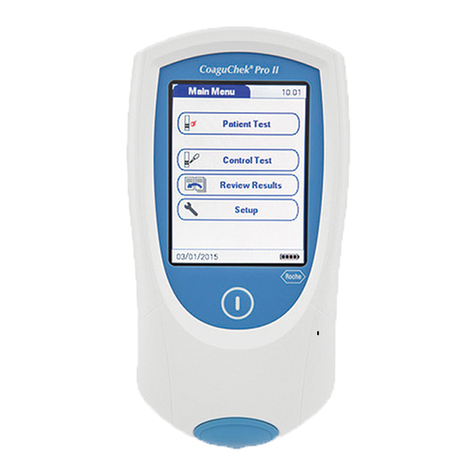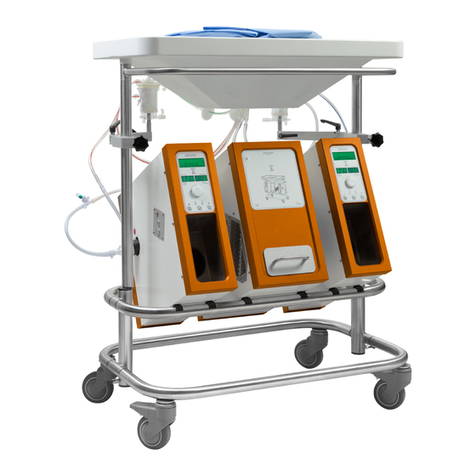myon m320 User manual

Transmitter, Receiver, Charging Cradle
Model: myon m320
USER MANUAL

History of changes
Version Author Date Comments
1.0 myon AG 06.10.2011 Initial release.
1.1 myon AG 18.01.2012 Minor changes.
1.2 myon AG 21.03.2012 Minor addendum.
1.3 myon AG 07.05.2012 Minor addendum and changes.
1.4 myon AG 14.06.2012 Enhanced usage guidance.
1.5 myon AG 23.08.2012 Minor addendum and some smaller changes.
1.6 myon AG 03.01.2013 Address changes and minor corrections.
1.7 myon AG 28.04.2014 Added device verification procedures; added mains plug instructions;
updated FCC information; technical data addendums; corrections.
Date: 28.04.2014 LaInMa-EU-m320 - Instructions manual (full version, english) - 20140428 - V1.7.odt Page 2 of 37
VERSION 1.7 / 28.04.2014

Copyright
Copyright © 2009-2014 myon AG. All rights reserved. This publication may not, without the prior
written permission of myon AG, be reproduced in any form or by electronic, mechanical, magnetic,
optical, chemical, manual or other means, transmitted, transcribed, stored in a retrieval system or
translated into any language or computer language.
Disclaimer
myon AG does neither directly nor indirectly guarantee the accuracy of this manual and specifically
disclaims any warranties as to the quality or fitness for a particular purpose. Furthermore, myon AG
reserves the right to revise this publication without notice and to make changes to the content.
Technical changes reserved. As a result of further technical development, illustrations and technical
data may differ.
myon AG makes no warranties, express or implied, as to the quality and performance of this product
including but not limited to, any implied warranty of applicability for other than research uses by
qualified individuals. myon AG shall not be liable to any person for any medical expenses or any
direct or consequential damages resulting from any defect, failure or malfunction, whether a claim
for such damage is based upon theory of warranty, contract, tort or otherwise. No representative,
agent, or licensed practitioner is authorized to waive this disclaimer. myon AG makes no diagnosis or
prescription by virtue of anything about this product.
Date: 28.04.2014 LaInMa-EU-m320 - Instructions manual (full version, english) - 20140428 - V1.7.odt Page 3 of 37

Table of Contents
1 Important information............................................................................................................................................6
1.1 Introduction...................................................................................................................................................................6
1.2 Conventions used in this text........................................................................................................................................6
1.3 Important information..................................................................................................................................................6
1.4 Power supply safety.......................................................................................................................................................7
1.5 Cleaning and care...........................................................................................................................................................7
1.6 Maintenance..................................................................................................................................................................7
2 Preface....................................................................................................................................................................8
2.1 Intended use..................................................................................................................................................................8
2.1.1 Transmitters.....................................................................................................................................................................8
2.1.2 Receivers..........................................................................................................................................................................8
2.1.3 Charging Cradles..............................................................................................................................................................8
2.2 Contraindications..........................................................................................................................................................8
2.3 Possible combinations..................................................................................................................................................9
3 System overview...................................................................................................................................................10
3.1 Power supplies.............................................................................................................................................................10
3.1.1 Power supply leads with and without ferrite................................................................................................................11
3.1.2 Country specific mains plug...........................................................................................................................................11
3.2 Transmitter..................................................................................................................................................................12
3.2.1 Reset switch...................................................................................................................................................................12
3.3 Receiver.......................................................................................................................................................................13
3.4 Charging cradle............................................................................................................................................................13
4 LED function indicators.........................................................................................................................................14
4.1 Transmitter..................................................................................................................................................................14
4.2 Receiver.......................................................................................................................................................................14
4.3 Charging cradle............................................................................................................................................................14
5 Operation..............................................................................................................................................................16
5.1 Parts included in shipment..........................................................................................................................................16
5.2 Unpacking and transport.............................................................................................................................................16
5.3 Device installation.......................................................................................................................................................17
5.4 Charging of transmitters.............................................................................................................................................18
5.5 Conduction of measurements.....................................................................................................................................19
5.5.1 Establishing a wireless connection..............................................................................................................................19
5.5.2 Capturing and transmission of sensor signals...........................................................................................................19
5.5.3 Transmitters with EMG sensor cable..........................................................................................................................20
5.6 Recommendations for optimal signal transmission and radio coverage....................................................................20
5.6.1 Receiver..........................................................................................................................................................................21
5.6.2 Transmitter....................................................................................................................................................................21
6 Turning off the device...........................................................................................................................................22
6.1 Transmitters................................................................................................................................................................22
6.2 Receiver.......................................................................................................................................................................22
6.3 Charging cradle............................................................................................................................................................22
7 Checks...................................................................................................................................................................23
7.1 Verification procedure for the correct functioning of the equipment...........................................................................23
Date: 28.04.2014 LaInMa-EU-m320 - Instructions manual (full version, english) - 20140428 - V1.7.odt Page 4 of 37
VERSION 1.7 / 28.04.2014

7.1.1 Visual check of basic functions......................................................................................................................................23
7.1.2 Check of installation and wiring....................................................................................................................................24
7.1.3 Check of transmitter's sensor cable integrity..............................................................................................................25
8 Solving problems..................................................................................................................................................26
9 Technical description.............................................................................................................................................27
9.1 Technical data..............................................................................................................................................................27
9.2 Description of interfaces.............................................................................................................................................28
9.2.1 Models with analog EMG output for up to 16 channels.............................................................................................28
9.2.2 Models with analog EMG output for more than 16 channels....................................................................................29
9.2.3 Pin assignment of DSub25 connector........................................................................................................................29
9.3 Technical support........................................................................................................................................................30
9.3.1 How your EMG signals should look like.......................................................................................................................30
9.3.2 Visualization of transmission errors...........................................................................................................................30
10 Regulatory Information.......................................................................................................................................32
10.1 Name and address of the manufacturer....................................................................................................................32
10.2 Identification of the devices covered.........................................................................................................................32
10.2.1 Trade or proprietary names.........................................................................................................................................32
10.3 International Electrotechnical Commission (IEC)......................................................................................................32
10.4 For customers within the European Economic Area..................................................................................................32
10.4.1 Restriction of the Use of certain Hazardous Substances in Electrical and Electronic Equipment (RoHS)...........32
10.4.2 Registration, Evaluation, Authorisation and restriction of CHemicals (REACH)...................................................33
10.4.3 Waste Electrical and Electronic Equipment (WEEE)................................................................................................33
10.4.4 Declaration of Conformity..........................................................................................................................................34
10.4.5 Medical Device Adverse Event Reporting.................................................................................................................34
10.5 For customers within the United States of America.................................................................................................35
10.5.1 Federal Communications Commission (FCC).............................................................................................................35
10.5.2 Statement of Declaration of Conformity..................................................................................................................36
10.6 For customers within all other countries...................................................................................................................36
11 Safety and usage guidance...................................................................................................................................37
Date: 28.04.2014 LaInMa-EU-m320 - Instructions manual (full version, english) - 20140428 - V1.7.odt Page 5 of 37

1 Important information
1.1 Introduction
In this manual you will find important information, needed for the commissioning and operation of
the device.
Always adhere to the safety instructions in the manual of your computer or other systems involved
and the ones in this handbook! If you experience any problems, please contact your local sales
agency or the respective manufacturer.
1.2 Conventions used in this text
Throughout this manual the following conventions are used.
Indicates important information that may damage your health, the functioning of the
device or the safety of your data if not adhered to.
Indicates additional information and tips.
1.3 Important information
Please follow these safety instructions
to ensure your safety and the optimal functioning of the device.
The product may be used only as intended (see Section 2.1) and in compliance with the instructions
in this user manual, by appropriately trained and qualified personnel. Assembly, modifications,
maintenance and repairs have to be carried out by the manufacturer or personnel authorized by the
manufacturer.
Repair attempts by the user are not permitted and will result in a loss of warranty as
well as in a loss of conformity with regulatory requirements voiding the user’s
authority to operate the device.
The product can only be used in combination with accessories, that are specified in the user manual
or by the manufacturer by other means. Other combinations, accessories and consumable parts may
only be used if they are specifically designed for the intended application and do not affect
performance, and safety requirements.
Date: 28.04.2014 LaInMa-EU-m320 - Instructions manual (full version, english) - 20140428 - V1.7.odt Page 6 of 37
VERSION 1.7 / 28.04.2014

The device contains Lithium-Polymer batteries. Do not damage, crush, burn, freeze or otherwise
mishandle the device. Recharge only with the power supply and charging cradle supplied with your
myon m320 system.
1.4 Power supply safety
•Disconnect the system from the mains when not in use. You can disconnect the receiver and
the charging cradle by pulling the power plug from the mains power outlet.
•The power cord in devices with mains plugs is used for separation from the mains. The
power outlet must be located in the vicinity of the device and must be easily accessible.
•The power supplies must be used with a suitable power outlet. If you are not sure if the
outlet is suitable, please contact the local power company.
•Make sure that your power supply is equipped with the correct country specific mains
adaptor and that the adapter is correctly and firmly installed.
•The device is not suitable for use outdoors.
•The device is not suitable for unattended continuous operation.
1.5 Cleaning and care
•Unplug the power cord from the outlet before cleaning a device.
•The devices can be cleaned with a slightly water and/or alcohol moistened, soft, lint-free
cloth. Do not use harsh cleaners, aerosol cleaners or glass cleaners.
•Objects or liquids must not get into the interior of the device.
•Check the device after each cleaning to its functions and to possible damage occurred. If you
notice any damage, do not make any repair attempts, but contact your sales agency or the
manufacturer.
To maintain functionality of the myon system all electrical contacts should always be
kept clean.
In particular, adhesive tape or similar substances must not be attached to the
charging contacts of the transmitter or the charging cradle slots' contacts.
Please note that myon offers special fastening straps (P/N PA0003 ... PA0009) for the
purpose of affixing the transmitter securely to the body.
1.6 Maintenance
No user serviceable parts inside. Do not open or remove the protective housing yourself as you might
expose yourself to dangerous voltages and other risks. In case of abuse or accident (such as dropping
the unit or improper use) please contact your local sales agency or the manufacturer for
maintenance. Store all devices in a secure and dry place when not in use.
Date: 28.04.2014 LaInMa-EU-m320 - Instructions manual (full version, english) - 20140428 - V1.7.odt Page 7 of 37

2 Preface
2.1 Intended use
The myon320 system is designed to capture and wirelessly transmit EMG sensor signals recorded
from human muscles. The myon320 can not be used for the electrical stimulation of muscles.
All product models and types of the product may only be used externally and non-invasively by
professional users (e.g. healthcare professionals, doctors, researchers, etc.). Only the components
(sensors, power supply, etc.) supplied by the manufacturer are to be used. Additional sensors or
spare parts are available upon request from the manufacturer.
2.1.1 Transmitters
The transmitters are intended to record a signal from a pair of electrodes. The recorded signal is
immediately digitized and transmitted to the receiver.
The electrode sensor cables are made from material allowing the implementation of
thin leads with a very high grade of flexibility to reduce cable and movement
artefacts.
However, please keep in mind, that the sensor cables have a limited capability of
dealing with mechanical stress. You therefore must avoid any tractive and/or shearing
forces and/or torsion to be applied onto the sensor cables.
2.1.2 Receivers
The receivers are intended to receive the sensor data from the transmitter and to output the
received data via an analogue output interface for further use with 3rd party hardware systems
and/or software.
2.1.3 Charging Cradles
The charging cradle is used to re-charge the transmitter batteries. It is also intended as a place in
which to safely store the transmitters when they are not in use.
2.2 Contraindications
Do not use the device on patients with implanted electronic devices of any kind (e.g. cardiac pace
makers). The device must not be used in critical care settings / applications or on irritated skin or
open wounds.
If the device is used on a patient also connected to high-frequency surgical equipment, such usage
may result in burns at the site of the EMG sensor.
The medical practitioner and/or user always has to decide on the basis of the general condition of
the patient or subject whether or not the intended application is reasonable. Further information is
Date: 28.04.2014 LaInMa-EU-m320 - Instructions manual (full version, english) - 20140428 - V1.7.odt Page 8 of 37
VERSION 1.7 / 28.04.2014

accessible in current scientific literature.
The device is not intended for use in an operating theatre, anesthetic gas or oxygen-rich
environments. Not for use where there is a risk of compromising the essential performance of
medical electrical equipment. Not suitable for use in high magnetic flux, ionizing radiation, sterile,
or life- or safety-critical environments. The device is not suitable for unattended continuous
operation.
2.3 Possible combinations
In addition to these instructions, the instructions of those products used in combination (e.g.
analog-to-digital converters, video motion capture systems, EMG electrodes) must also be observed.
Potential electromagnetic or other interference that occurs between the product and other products
may lead to disturbances or malfunctions.
Date: 28.04.2014 LaInMa-EU-m320 - Instructions manual (full version, english) - 20140428 - V1.7.odt Page 9 of 37

3 System overview
The systems is comprised of three main components: Transmitter, charging cradle and receiver.
Image 1: Transmitter Image 2: Charging cradle Image 3: Receiver
3.1 Power supplies
Receiver and charging cradle each require a different specific medical grade external power supply to
operate.
Image 4: Power supply
•Mains power supply
•Country specific mains
plug
•Device's power supply
plug with mechanical
reverse voltage protection
Date: 28.04.2014 LaInMa-EU-m320 - Instructions manual (full version, english) - 20140428 - V1.7.odt Page 10 of 37
VERSION 1.7 / 28.04.2014

3.1.1 Power supply leads with and without ferrite
Please note that although both types of power supplies are basically identical, for regulatory
purposes, m320 charging cradles require the use of a power supply with a ferrite additionally
attached to its lead (see Image 5).
In contrast, m320 receivers may be powered by a standard power supply without ferrite.
Image 5: Power supply lead with and without ferrite
•Without ferrite: for use
with receiver (PA0014)
•With ferrite: for use with
charging cradle (PA0016)
3.1.2 Country specific mains plug
The primary plug is interchangeable. This allows a world wide use. The procedure of changing the
plug is shown in Image 6.
Image 6: Assembly of primary plug (Image courtesy of FRIWO Gerätebau GmbH, Germany)
Power supplies other than those shipped with the myon320 system
must not be used.
Date: 28.04.2014 LaInMa-EU-m320 - Instructions manual (full version, english) - 20140428 - V1.7.odt Page 11 of 37

3.2 Transmitter
Image 7: Transmitter
•Channel number
•LED function indicator
•Charging contacts
•Reset switch
3.2.1 Reset switch
In case the transmitter doesn't start transmitting or should stop operation, first check that the
transmitter is fully charged. Re-insert the transmitter into a charging slot for a few seconds and try
again.
If this doesn't help, resetting of the device may be required.
A reset must not be carried out without prior advice by the myon support team.
To perform a hard-reset carefully insert the tip of a ball pen into the opening on the side of the
transmitter housing and gently press and hold down the reset micro switch for about 5 seconds. The
transmitter should restart itself and begin operation immediately. Please make sure that the
transmitter has enough battery capacity left to start operation.
It may take up to 1 minute for the transmitter to restart after a reset.
Date: 28.04.2014 LaInMa-EU-m320 - Instructions manual (full version, english) - 20140428 - V1.7.odt Page 12 of 37
VERSION 1.7 / 28.04.2014

3.3 Receiver
Image 8: Receiver
•LED function indicators
(inside of housing)
•External power supply
•DSub25 analog output
3.4 Charging cradle
Image 9: Charging cradle
•4 charging slots (4 more
are on the other side of
the device)
•4 LED function indicators
(4 more are on the other
side of the device)
•External power supply
Date: 28.04.2014 LaInMa-EU-m320 - Instructions manual (full version, english) - 20140428 - V1.7.odt Page 13 of 37

4 LED function indicators
4.1 Transmitter
The transmitter indicates its state as described below:
•When removing the transmitter from the charging cradle, the blue transmitter LED located
inside the housing will flash for about 2 minutes to signal the proper operation of the
transmitter.
•After about 2 minutes the transmitter LED is switched off.
Thus, during a measurement, there is no LED indication of transmitter operation. This is to
prevent the distraction of patients by simultaneous flashing of a relatively large number of
transmitter LEDs.
•If during a measurement the remaining capacity of the built-in battery reaches a low value,
the transmitter's LED will begin to flash again. In this state further operation of the
transmitter is possible for a maximum of about 30 minutes before the transmitter will be
switched off automatically. The flashing frequency will be noticeably higher and it is
advisable to put the transmitter back into the charging cradle to reload its batteries.
4.2 Receiver
•Within the receiver's enclosure there is one blue LED for each transmitted channel.
•As soon as a wireless connection between a transmitter and the receiver has been
established successfully, the respective receiver LED will start flashing.
4.3 Charging cradle
Each charging slot of the charging cradle features a single indicator LED located beneath the slot.
The indicator LED indicates three states:
•Battery is re-charging:
In this state, the charging slot indicator LED will blink at a low frequency, indicating that re-
charging of the transmitter's build-in battery is in progress. Please note, that the re-
charging process - and therefore blinking of the indicator LED - might take place from time
to time even if the transmitter has not been used and stayed in its slot in the charging
cradle.
Please check each time you insert a transmitter into a charging slot that the
respective charging slot LED starts blinking to make sure the re-charging
process started successfully.
•Battery fully charged:
After the transmitter's battery has been fully re-charged, the charging slot indicator LED is
illuminated constantly.
•Empty charging slot / transmitter not properly inserted:
If a charging slot is empty, the respective charging slot indicator LED will not light up. The
Date: 28.04.2014 LaInMa-EU-m320 - Instructions manual (full version, english) - 20140428 - V1.7.odt Page 14 of 37
VERSION 1.7 / 28.04.2014

same happens if a transmitter has been inserted incorrectly into a charging slot and thus the
electrical contact between transmitter and charging cradle cannot be established.
Date: 28.04.2014 LaInMa-EU-m320 - Instructions manual (full version, english) - 20140428 - V1.7.odt Page 15 of 37

5 Operation
5.1 Parts included in shipment
The myon system is shipped in a durable carrying case. Depending on your individual system
configuration, you may find a varying number of parts and accessories as part of your shipment in
the carrying case:
•The number of transmitters you ordered, including the EMG sensor cable.
•A sufficient number of single-use electrodes will be included in the shipment to allow you
to conduct at least one measurement with all transmitters at the same time .
•A receiver, including power supply and an analog connector cable (for the analog output
version of the receiver).
•As many charging cradles as required to charge all ordered transmitters at the same time.
The appropriate number of power supplies is also included.
•This printed manual.
•The carrying case.
5.2 Unpacking and transport
The system is shipped in a durable carrying case that prevents the system from being damaged. It is
therefore recommended to use the provided carrying case to store the system if you plan not to use
the system for a longer period of time or if you would like to take the system with you on a journey,
e.g. by plane.
Also the carrying case shall always be used in case the device needs to be shipped, e.g. for repairs.
Date: 28.04.2014 LaInMa-EU-m320 - Instructions manual (full version, english) - 20140428 - V1.7.odt Page 16 of 37
VERSION 1.7 / 28.04.2014

Image 10: Carrying case
•Carrying handle
•Fasteners (press dimple
to open)
5.3 Device installation
The installation of the system must be done by adequately qualified personnel.
•Place the receiver and the charging cradle on a flat surface.
•Plug the power connector for the receiver into the power socket on the receiver.
Do the same for the charging cradle. Do not plug in the mains connector, yet.
•Next, you will have to connect the socket for analog output signals to your specific recording
system (e.g. a Vicon Motion Capture System or a National Instruments ADC):
For the preparation of this interface specific technical knowledge may be
required. If you do not have the necessary skills, please consider consulting an
expert.
For this connection a specifically designed adapter cable may be required.
The analog ouput is designed to be acquired with “single ended” inputs of an
analog-to-digital converter only. No “differential” input configuration must be
used.
◦Dismantle each individual cable of the supplied DSub cable that you intend to connect
to your individual analog capture unit. Do not dismantle any cable that will not be
connected. If cables have already been dismantled that will not be connected, re-
Date: 28.04.2014 LaInMa-EU-m320 - Instructions manual (full version, english) - 20140428 - V1.7.odt Page 17 of 37

insulate them with electrical tape.
◦Connect each individual cable of the supplied DSub cable to the relevant screw terminal
for the analog capture unit you wish to use. See Section 9.2.3 for pin assignment details.
◦Make sure that electric ground is correctly and firmly connected.
◦Make sure you chose the correct assignment of the individual pins (see Section 9.2 for
details).
◦Connect the 25-pin DSub cable plug to the analog output connector of the receiver.
•Plug the external power supplies of receiver and charging cradle into a mains power outlet.
You will see several blue LEDs light up inside the receiver. Blue LEDs of the charging cradle
will light up if transmitters are inserted (see Section 5.4).
•You may now also turn on your specific recording system (e.g. Vicon) as well as all other
interacting systems (e.g. force plates, etc.).
5.4 Charging of transmitters
•Make sure that the charging cradle is connected to its external power supply.
•If not done already carefully place each transmitter in a charging slot: Insert it by vertically
pushing the transmitter into the charging slot. Then let the transmitter snap into place by
pushing the top of the transmitter as shown in the three images below.
Make sure that no double sided tape or similar adhesive material still remains
on the transmitter's rear side from the last measurement. This could make it
difficult to remove the transmitter from the charging cradle after charging.
•When charging, the charging slot indicator LED will start to flash. This indicates that re-
charging of the transmitter's battery is in progress. After the battery has been recharged,
the charging slot indicator LED is lit constantly. See Section 4.3 for details.
Charging transmitters: Step 1 Charging transmitters: Step 2 Charging transmitters: Step 3
Date: 28.04.2014 LaInMa-EU-m320 - Instructions manual (full version, english) - 20140428 - V1.7.odt Page 18 of 37
VERSION 1.7 / 28.04.2014

•Depending on the charge condition of the battery, the re-charging process can take between
30 and 90 minutes. When the battery is charged for the first time, the charging process may
take longer.
You cannot overcharge the battery.
You can top up the battery by charging it before it is fully exhausted.
Further increasing battery life
All transmitting modules are equipped with newest generation LiPo batteries
that do not suffer the problem of “memory effect” common to older batteries.
These batteries can be recharged any time regardless of their current charge
condition without reducing the performance of the battery.
In addition, in certain situations, the battery life can be increased further by
observing the following instructions:
•When the system is not in use for a short time, the batteries should be
charged. The transmitter modules may be plugged into the charging
cradle all the time when the system is not in use.
•When the system is not in use for an elongated period of time, the
whole system - including receiver and charging cradle - has to be
disconnected from the mains.
5.5 Conduction of measurements
It is recommended that you verify the correct function of your equipment prior to important
measurements or if you have any doubts concerning the integrity of your system. See Section 7 for
details.
5.5.1 Establishing a wireless connection
•Make sure that the receiver is connected to its external power supply. You will see blue LEDs
inside the unit.
•Take the transmitters you need from the charging cradle.
•The transmitters' LEDs will start flashing. This indicates that the transmitter is transmitting
data.
The transmitter indicates its state by its indicator LED
as described in Section 4.1.
•An LED in the receiver will start flashing. There is one LED per transmitter. When the LED is
flashing, the data from the transmitter is received.
5.5.2 Capturing and transmission of sensor signals
•With the steps described in Section 5.5.1 the wireless connection is established and the
device is ready to start measuring.
Date: 28.04.2014 LaInMa-EU-m320 - Instructions manual (full version, english) - 20140428 - V1.7.odt Page 19 of 37

•A minimum sampling rate of 2.000 Hz is highly recommended for each analog output
channel.
5.5.3 Transmitters with EMG sensor cable
The following single-use electrodes are recommended for use with m320
transmitters:
•Ambu Blue Sensor N, Item No.: N-00-S/25.
Specially developed for children for short- to mediumterm application.
•Ambu Neuroline 720, Item No.: 720-00-S/25.
Strong yet skin-friendly adhesive for mid- to long-term application.
Both manufactured by Ambu A/S, Baltorpbakken 13, DK-2750 Ballerup,
Denmark. www.ambu.com.
•Prepare the muscle areas to be measured. Please see clinical guidelines for measuring
surface EMG.
•Attach a pair of electrodes to each muscle. Please consult clinical guidelines to find the best
place and on how to affix the transmitter securely to the body. A good place to start may be
the European SENIAM project (Surface ElectroMyoGraphy for the Non-Invasive Assessment
of Muscles) at www.seniam.org.
•Affix the transmitters securely to the body near to each pair of electrodes. Consider using
myon's special re-usable fastening straps (P/N PA0003 ... PA0009) for quick and easy re-
adjusting of the transmitters position.
Make sure that you do not touch any accessible contacts of connectors and
patient simultaneously.
•Connect a pair of electrodes to the sensor cable. The connectors on the cable will snap onto
the electrode.
•Take a look at the software used with the system for data acquisition to check the signal.
The software will show the signal in real time. Make sure the signal quality is good before
you conduct your experiments.
5.6 Recommendations for optimal signal transmission and radio coverage
Because of the physical nature of wireless transmission, radio signals sent by the transmitter are
not guaranteed to reach the receiver. The maximum legal limit on the transmission power means
that the maximum theoretical transmission distance is up to 200 metres. In practice, indoor
environments tend to limit the distance to 20-30 metres. Walls, floors and furniture limit the
transmission range depending on what type of material they contain. Concrete walls, for example,
are not easily penetrated, and such walls will limit the range.
Low signal strength at the receiver can be caused by poor positioning of the receiver as well as
interference from other sources of radio waves such as wireless LAN, mobile or cordless phones or
an active microwave oven. Please read the next sections carefully and follow the recommendations
to achieve optimum range of the system.
Date: 28.04.2014 LaInMa-EU-m320 - Instructions manual (full version, english) - 20140428 - V1.7.odt Page 20 of 37
VERSION 1.7 / 28.04.2014
Table of contents
Popular Medical Equipment manuals by other brands
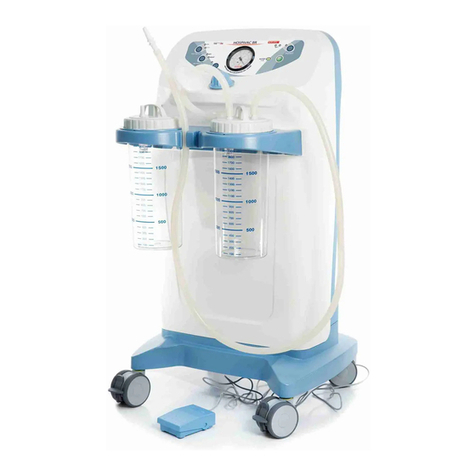
CA.MI
CA.MI NEW HOSPIVAC 400 manual
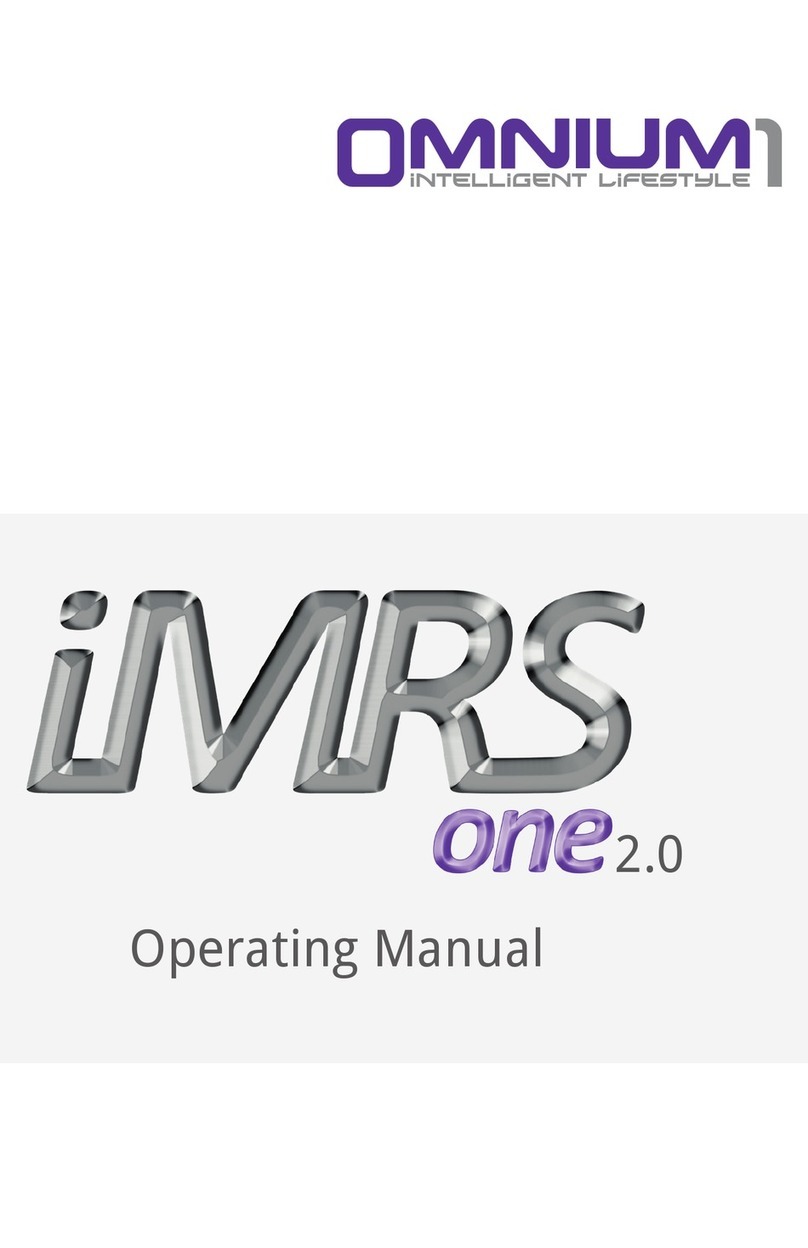
Swiss Bionic Solutions
Swiss Bionic Solutions Omnium1 iMRS one 2.0 operating manual
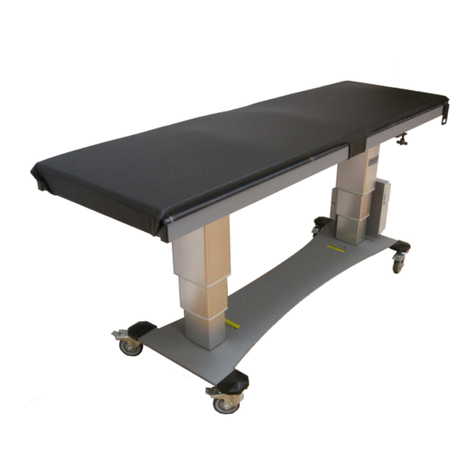
OAKWORKS
OAKWORKS DTPM 300 user manual

Stryker
Stryker 1188HD user guide
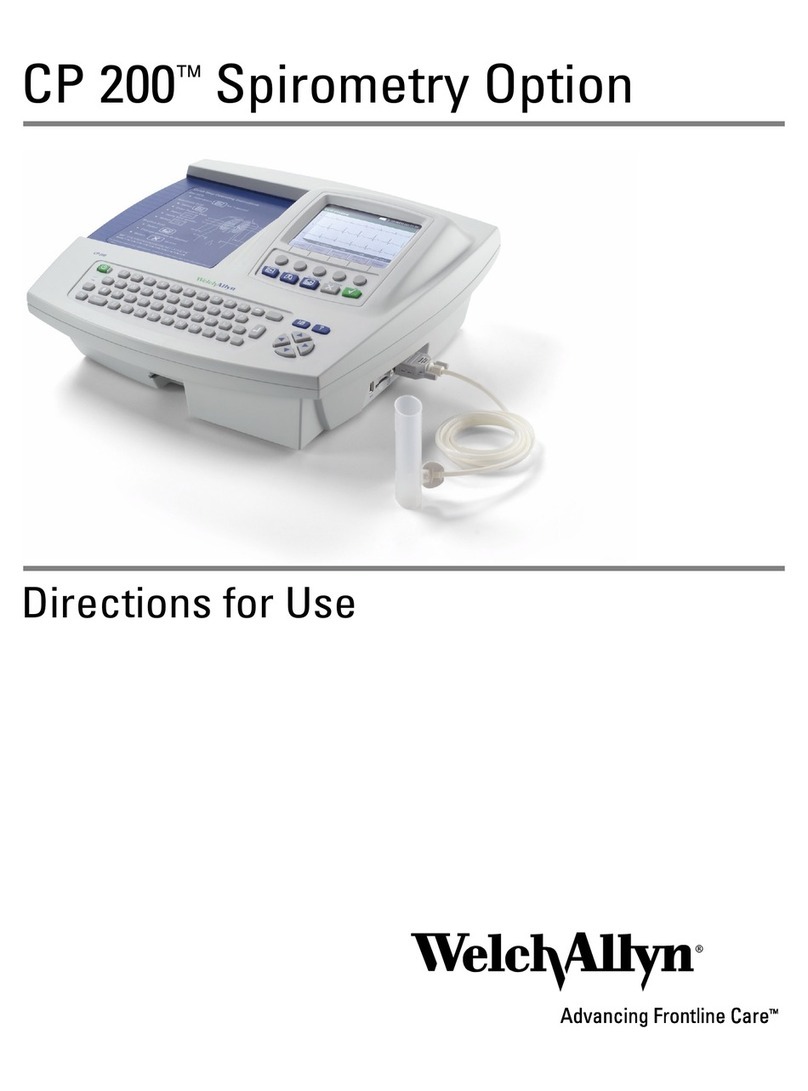
Welch Allyn
Welch Allyn CP 200 Directions for use
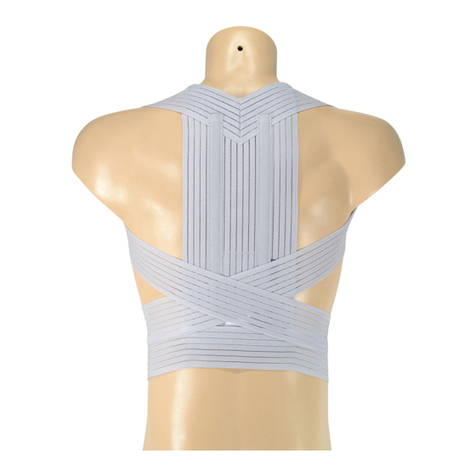
Otto Bock
Otto Bock 1068 Dosi EQ Posture Support Instructions for use
